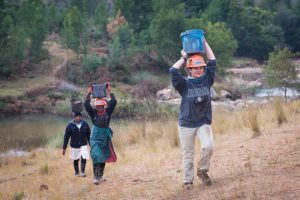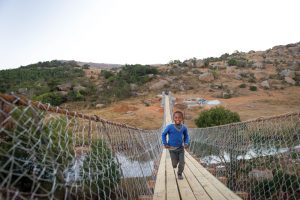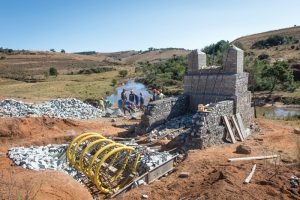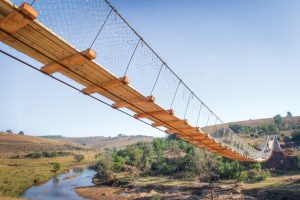Rural Isolation in Eswatini
Thombile Tsela is celebrating the fact she will no longer have to worry about her children being swept away by the Mbuluzi River on their way to school. Of the 1.4 million people in Eswatini, a small kingdom in southern Africa, approximately 75% walk as their primary mode of transportation. And, like Thombile, many of these people become isolated during the long rainy season as rivers swell and become impassable. This isolation is a root source of poverty not just in Eswatini, but around the world.
For ten weeks in 2017, the 200 families that make up the Edlangeni community worked together with students from the University of Colorado Boulder and the Engineers in Action Bridge Program to construct a 240-foot (73-meter) pedestrian suspended bridge. Being only the third engineered footbridge at the time in Eswatini, the Edlangeni Footbridge provides year-round safe access to essential resources such as education, healthcare, farm fields, and markets.
Footbridge Technology
Working in a remote community is a challenging endeavor due to a lack of electricity, skilled labor, and materials. The Edlangeni Footbridge design and construction team responded to these challenges by utilizing local materials and simple construction methods. The bridge design used at Edlangeni is a modification of a standardized suspended bridge design produced by Bridges to Prosperity. Due to the absence of a governing code, a variety of design checks utilizing the allowable stress design (ASD) methodology were performed to ensure the safety of the structure. The primary design checks included an analysis of the cable geometry to determine cable size and configuration, a check of the overturning moment induced at the top of the tower, a sliding check of the abutment, and a check for uplift of the anchor, among others. Unlike a project in the United States, much of the data required to verify design criteria, such as design wind speeds or allowable soil bearing pressures, was unavailable or too expensive to acquire. As a result, conservative assumptions for these design values are made for the worst possible conditions and factors of safety are increased. While acquiring the information could lead to a more efficient design, the relatively low cost of the construction materials and labor did not warrant it.
The walkway platform consists of a wooden deck, wide enough for livestock, motorcycles, wheelbarrows, and pedestrians. The platform is attached to wood crossbeams through a nailer. The crossbeams are attached to three walkway and two handrail cables by two pieces of rebar which are bent around both the handrail and walkway cables. The five 11⁄8-inch (28mm) steel cables are suspended between two 15-foot-tall (4.5-meter) stone masonry abutments. Masonry materials are sourced within walking distance of the bridge to reduce material costs. Rock is collected from the river or a nearby quarry and is then carried by hand or tractor to the bridge site.
Similarly, sand is collected from the river, screened and cleaned, and then hand-mixed with cement to make the mortar. The steel cables are anchored within the abutments by a reinforced concrete gravity anchor, each of which is comprised of 6.2 cubic yards (4.7 cubic meters) of hand-mixed concrete. The horizontal tension force in the cables is resisted by the mass of the entire abutment, while the vertical tension component is opposed by the mass of the anchor and associated overburden.
The majority of the construction process is spent collecting and moving materials to the job site, excavating the foundations by hand, and laying the masonry abutments. After the abutments are complete and the anchors are poured, the cables are raised with a lever hoist. The cable and corresponding deck shape are set using a simple automatic level. Hoisting the cables and setting the deck shape is the most critical aspect of the construction process and requires the most precision of any of the other construction processes. After the cables are correctly positioned and secured with wire rope clips, the crossbeams are launched. The wooden deck boards and fencing are then secured to the deck with lag screws and u-nails, respectively. The simplicity of the design and associated construction process allows for relatively fast implementation. The Edlangeni Footbridge took a total construction time of ten weeks between the ground-breaking and inauguration ceremonies and cost less than $100,000 (U.S.).
Partnerships
A multitude of stakeholders are associated with any project, and the Edlangeni Footbridge is no exception. While the bridge design and construction were led by the student chapter of Engineers in Action from the University of Colorado Boulder, under the supervision of a professional engineer, its completion would not have been possible without the support of the community and local partners. While the direct monetary cost of the bridge for the community members was close to zero, their primary contributions came in the form of providing unskilled labor for the project and their annual tax contributions to the national government which funded most of the materials. The families shared the labor responsibilities, each working an average of one to two days per week to carry rocks, collect sand, and hand-mix concrete. Eight students from the University of Colorado Boulder and two professional engineers traveled to Eswatini for the duration of the project and became part of the Edlangeni community, sharing the labor each day.

University of Colorado Boulder student, Maddie Philips, carrying sand alongside community members. Courtesy of Madison Sankovitz.
In addition to the community and students, the project was supported by a pseudo-governmental organization, Eswatini Microprojects, that is responsible for managing and developing the country’s rural infrastructure. The Microprojects organization consists of municipal engineers and builders who, in addition to assisting with the implementation, trained alongside the students in the design and construction of the footbridge. Microprojects, who is funded through the national government, was also responsible for contributing most of the materials, such as the wood and cement, while the student chapter fundraised in the U.S. to contribute the steel cables and clamps.
Student Engagement and Cultural Exchange
A unique aspect of the Engineers in Action Bridge Program is their partnership with university students in the U.S., Canada, and the UK. This partnership engages students in interactive design-build projects that sharpen technical skills learned in the classroom. Beyond refining their design skills, students learn how to communicate across cultures with community members and local engineers from different backgrounds. The singing and dancing that accompanies each day of a footbridge project create a space for this cross-cultural exchange of ideas. Not found in most engineering curriculums, this exchange allows students to gain a global perspective on how structural engineering is really about people and not just equations and calculations. By working on resource-limited projects like the Edlangeni Footbridge, students become better equipped to enter the engineering workforce. On-site, students are faced with unique problems that require them to think outside the box for solutions, an experience not typically encountered in summer internships. For example, while digging an anchor pit with just picks and shovels, and encountering a 1000-pound boulder, creativity is necessary for either finding safe ways to move it without heavy machinery or adapting the design to accommodate it. Because the students participating in these projects are not siloed into either design or construction, they are empowered to create and evaluate each alternative to make the best decision while in the field.
Celebration of New Beginnings
On a sunny July afternoon, the completion of the Edlangeni Footbridge was celebrated by the community, students, and partners who made the project possible. Children ran back and forth over their community’s new bridge, testing out their new, elevated path to school. Parents relaxed, knowing that their children and grandchildren would have a safe river crossing for years to come. Moreover, the students from the University of Colorado Boulder reflected on all that was learned through the year-long design-build project. The Edlangeni Footbridge marked the start of the EIA Eswatini Bridge Program, led by university students and recent alumni, which aims to provide safe access over impassable rivers to all citizens of Eswatini. Since 2017, six bridge projects have been completed in Eswatini and many more are in the planning process. For more information and pictures about the Edlangeni Footbridge Project, please visit https://bit.ly/2k4zZno.

The completed Edlangeni Footbridge provides safe access for children to attend school year-round. Courtesy of Madison Sankovitz.
Become a Bridge Builder
As a small but efficient non-profit organization, Engineers in Action thrives on the passion and commitment of volunteers. Whether you are a student seeking ways to use your studies to make a difference in the world, or a professional interested in mentoring the next generation of global change-makers, you can find out more by visiting www.engineersinaction.org.■


